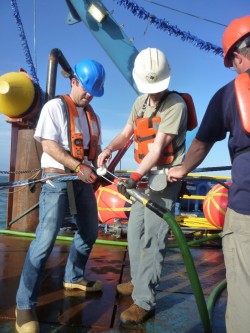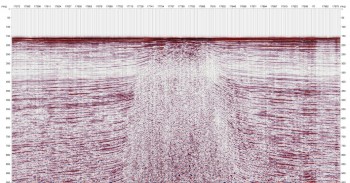Meckel Leads University’s Second Cruise to Collect 3D Seismic Data with Novel P-Cable Technology
November 18, 2013

In October 2013, the Bureau of Economic Geology’s Tip Meckel led a crew of 27 on a 10-day 3D seismic data collection cruise off the Texas coast in the Gulf of Mexico. This activity was part of a multi-year geologic characterization effort to identify potential carbon dioxide (CO2) storage sites beneath the Texas portion of the Gulf of Mexico within 10 miles offshore. The seismic data were collected using the new P-Cable system manufactured by Geometrics, which is designed to provide extremely high resolution 3D data for relatively shallow stratigraphic depths (<1500 m). The Bureau of Economic Geology, a research unit in the Jackson School of Geosciences at the University of Texas at Austin, is the only research institution in the United States (and among a handful globally) that currently operates such high resolution 3D (HR3D) seismic acquisition technology, which was deployed for the first time ever in the Gulf of Mexico in 2012 by Meckel and his team.
These shallow depths have previously been of secondary interest to the hydrocarbon industry, but are increasing in interest in relation to shallow geohazard identification and understanding subsurface fluid migration processes related to seafloor fluid seeps. The tool provides important data for linking the deepest and shallowest portions of marine stratigraphy. Research interests include structurally-controlled fluid migration, 3D stratigraphic architecture, reservoir morphology analogs, and Cenozoic/Quaternary stratigraphic evolution.
In addition to Meckel, science staff from the University of Texas at Austin included Nathan Bangs (Institute for Geophysics) and Dallas Dunlap (Bureau of Economic Geology), as well as SMU graduate student Ben Phrampus. Logistical coordination and project management from shore was led by the Bureau’s Ramon Trevino. Vessel services were provided by TDI-Brooks International using the R/V Brooks-McCall vessel based out of Freeport, TX. Technical participation included Finn Michelsen of GeoSurvey Systems, assisted by Rick Hubneur of Seismic Equipment Solutions. Paravane expertise contracted with Glen Barker of GB Consulting. NCS SubSea, Inc. provided array geometry solutions and navigation for real-time coverage mapping. Portable air compression units were provided by Alpha Seismic Compressors. This research is funded through the Department of Energy National Energy Technology Laboratory’s carbon sequestration research program and the Texas General Land Office (GLO).

The 2013 seismic array consisted of one GI-airgun source (90 cu. in.) and twelve 25-m-long, 8-channel streamers (total 96 channels). Over 400 line-km (> 250 miles) were shot in an area offshore southern Galveston Island, adjacent to and including portions of the San Luis Pass shallow salt dome. The goals of the survey were to image subsurface stratigraphy and fault structure above a reservoir interval for a Miocene-age CO2 storage prospect at ~2,000 m depth. Of particular interest is the ability to identify (or not) the occurrence of any shallow faults or indications of prior historic hydrocarbon fluid migration to the seafloor, which may inform interpretations of sealing conditions in the deeper stratigraphy above the prospective reservoir CO2 storage interval. Such determinations advise our understanding of potential long-term risks of CO2 storage by providing information relevant to storage on the performance of specific geologic settings for retaining naturally sourced hydrocarbons.
Initial results indicate that the seismic system will be an extremely valuable tool for imaging subsurface volumes in high resolution and identifying, understanding, and reducing risks of offshore storage projects by proving up regional sealing characteristics over large continuous areas. Interest from industry has been building and acquiring datasets such as these are an important part of developing a variety of anticipated commercial applications of HR3D technologies. Data processing from the October cruise is ongoing and one more Gulf of Mexico cruise for the current study is planned for 2014.
Read about the first cruise in this multi-year project.
Learn about the Gulf Coast Carbon Center.
